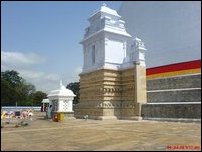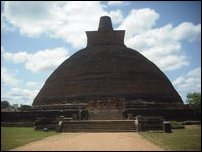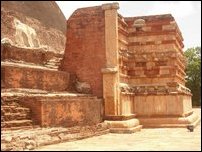Know the Etymology: 192
Place Name of the Day: Monday, 28 February 2011
Wahalkada
வாஹல்கட
WāhalkaḍaWaahal+kada
The outer entrance
The entrance side
The entrance part
| Waahala |
Also Waasala: Door, gate, gate or entrance to a city, royal gate, entrance or antechamber of a palace (Sinhala); Vaayil, Vaayal, Vaasal: Doorway, entrance, gate, place, king’s court, (Tamil, Malayalam, Dravidian Etymological Dictionary 5354); from the verb root Vaa: To come (Tamil, DED 5270); Vaay: Mouth, opening, entrance (Tamil, DED 5352); Vaakili: Door (Telugu, DED 5354); Baagilu: Door (Kannada)
|
| Kadai |
End, limit, boundary, entrance, gate (Tamil, DED 1109); from the verb root Kada: to pass through, cross etc (Tamil, DED 1109); Kadavu: Way, path direction (Tamil, DED 1109); Kadavai: Passing over, way (Tamil, DED 1109); Kade: To pass over, limit, end, side, direction (Kannada, DED 1109); Ak-kade: That side (Kannada); Ik-kade: This side (Kannada); Kede: The end (Dhivehi/ Maldivian); Kada: Piece, part, fragment (Sinhala); also means, side, space (Sinhala place names); Kada-ima: Limit, boundary of a country, frontier (Sinhala); Kadawata: The post to pass through at a boundary (Sinhala); Kadawala, Kaduwa: Spot or locality to pass through (Sinhala place names); Dora-kada: Doorway, about the door, near the door (Sinhala; Dora < Dvaara in Sanskrit) Also see column on Pa’lu-kadawala, Hik-kaduwa, Iluppaik-kadavai |
| Waahal-kada |
The architectural piece of façade (a stylistic entrance motif) built on the four sides of a stupa (Sinhala); Vaayil-kadai, Vaasal-kadai: Main entrance, outer entrance (Tamil, Glossary of Historical Tamil Literature); Puzhaik-kadai: The rear gangway, the backside gate which is usually small, backyard, the last sluice in a tank (Tamil, Puzhai: narrow opening, hole, narrow path etc, DED 4317); Kadai-vaasal: Outer gate, entrance (Tamil, MTL); Waahal-habaya: King’s court (Sinhala; Habaya < Sabhaa in Sanskrit; one meaning of Vaasal/ Vaayil is kings court in Tamil, DED 5354) |

A Wahalkada seen in full at Ruwanweli stupa at Anuradhapura [Image courtesy: imagemanjulanka.blogspot.com]

Note the Wahalkada in ruins at the base of Jethawanarama stupa at Anuradhapura [Image courtesy: sl-images.blogspot.com]

Wahalkada in ruins at the base of Jethawanarama stupa at Anuradhapura [Image courtesy: sl-images.blogspot.com]

Another example of Wahalkada ruins at Mihintale [Image courtesy: www.info.lk, wahalkada]
Waahal-kada is an architectural technical term in Sinhala, meaning a stylistic piece constructed to indicate an entrance into a stupa.
But Waahala and Waasala (S/H interchange) are also ordinary words in Sinhala diction, meaning a door, gate, entrance and even a royal gate.
The Sinhala words obviously correspond to Vaasal and Vaayil in Tamil and Malayalam, listed as words of Dravidian etymology (DED 5354) and meaning the same as in Sinhala. Etymologically they derive from the verb root Vaa, meaning to come and Vaay, meaning the mouth in Tamil/ Dravidian (DED 5270, 5352). Cognates could be found in several Dravidian languages.
Vaayil-kadai/ Vaasal-kadai or Kadai-vaayil/ Kadai-vaasal, as phrases in old Tamil, mean an outer entrance or main entrance of a building, premises etc. (See examples of usages below)
* * *The second component of the phrase, Kada in Sinhala and Kadai in Tamil have several shades of meaning.
In Tamil, coming from the verb root Kada (to pass, cross), Kadai itself means a door, entrance etc. (See usage examples below)
Corresponding to this meaning, the derivates Kadavai and Kadavu in Tamil mean a point to be crossed and in that sense those words are used in the place names too. The parallels in Sinhala place names are Kadawala and Kaduwa. (See column on
Pa’lu-kadawala, Hik-kaduwa and Illuppaik-kadavai)
Another shade of meaning for the word Kadai in Tamil is a space or side: end, either front or back, boundary, limit and the direction or space of that limit. (See usages below).
This shade of meaning is explicit in words of common usage in Kannada: Ak-kade (that side) and Ik-kade (this side).
For the word Kada, Colough’s Sinhala dictionary gives the meanings, piece, part and fragment, and relates the word to Kha’nda (piece, part, bit etc; Sanskrit/ Prakrit).
But in Sinhala vocabulary, there is another set of words/ phrases that have the component Kada unrelated to Khanda, but related to Kada of Dravidian discussed above.
For instance, in Sinhala, Kada-ima is a boundary and Kadawata is a post to pass through at a boundary.
Another Sinhala phrase Dora-kada, a synonym of Waahal-kada, is very clear in giving the meaning that kada in this context doesn’t mean a piece or part, but means a space.
Dora-kada, according to Colough’s dictionary, means doorway, about the door or near the door (see table).
Therefore, the specific meaning of Waahal-kada/ Waasal-kada in Sinhala and its identical Tamil counterpart Vaasal-kadai/ Vaayit-kadai, seems to be ‘the entrance space’ (the entrance and the side or space around it)
Another possibility is that the phrases in both Tamil and Sinhala are double nouns, in which two words of the same meaning are put together to coin an architectural technical term to specifically mean an outer entrance or main entrance.
However, in a number of Sinhala place names the component Kada (sometimes Kade) is used to mean a space or side. Such place names seem to be different from the ones having the components Kadawala and Kaduwa. See the examples listed below and also see the column on
Kadawala/ Kaduwa/ Kadavai. The usage Kada in the Sinhala place names seems to be closer to Kade in Kannada.
The word Kadai in Tamil and Kade in Sinhala are also used in another sense of meaning to mean a shop or bazzar, and place names having those components will be discussed separately in another column.
* * *Note the following usages of the words Vaayil/ Vaasal and Kadai in Tamil. Examples only relevant to the column are brought in here:
Vaayil as door of the house: “பலர் புகு வாயில் அடைப்பக் கடவுநர் வருவீர் உளீரோ எனவும்” (குறுந்தொகை 118:3-4)
“palar puku vaayil adaippak kadavunar varuveer u’leeroa enavum” (People of the house who wanted to close the doors used by many, made a call whether there were any more to come in; Ku’runthokai 118:3-4)
Vaayil as royal court: “வாயில் முற்றிய அவைப்புறம்” (பெருங்கதை 108:30)
“Vaayil muttiya avaippu’ram” (The royal court complete with its entrance; Perungkathai 108:30)
Vaayil-kadai, meaning an outer entrance/ main entrance of a palace “குடை ஒன்று கைப்பிடித்துக் கொற்றவனே வாயில் கடை வந்து அடைத்தான் காண் கண்டாய்” (பெருந்தேவனார் பாரதம் 3:143)
“Kudai on’ru kaippidiththuk kottavanea vaayil kadai vanthu adaiththaan kaa’n ka’ndaay” (Holding an umbrella, the king himself came to the outer entrance to close it; Peruntheavanaar Paaratham 3:143)
Vaasal-kadai as outer entrance/ main entrance of a house: “வீட்டின் முன் இடம் பனித் தலை வீழ நின் வாசற்கடை பற்றி” (ஆண்டாள் பாசுரம் 12)
“Veeddin mun idam panith thalai veezha nin vaasatkadai patti” (Holding on to your gate in front of the house while dew of the winter falls on head; Aa’ndaa’l Paasuram 12)
Kadai as last part: “தலைப் புணைக் கொளினே தலைப் புணைக் கொள்ளும், கடைப் புணைக் கொளினே கடைப் புணைக் கொள்ளும்” (குறுந்தொகை 222:2)
“Thalaip pu’naik ko’linea thalaip pu’naik ko’l’lum, kadaip pu’naik ko’linea kadaip pu’naik ko’l’lum” (If her friend holds the front side of the boat she also would hold the front side; if her friend holds the back side of the boat she also would hold the back side; Ku’runthokai 222:2)
Kadai as front part/ tip: “வெண்-கடைச் சிறுகோல் அகவன் மகளிர்” (குறுந்தொகை 298:6)
“Ve’n-kadaich chi’rukoal akavan maka’lir” (The singing women holding white-tipped small sticks; Ku’runthokai 298:6)
Kadai as space/ side: “நெருப்பு எனச் சிவந்த உருப்பு அவிர் மண்டிலம் புலங்-கடை மடங்கத் தெறுதலின்” (அகநானூறு 31:2)
“Neruppu enach chivantha uruppu avir ma’ndilam pulang-kadai madangkath the’ruthalin” (The fire-red scorching sun destroyed the space of cultivation fields; Akanaanoo’ru 31:2)
Kadai as gate/ entrance: “ஆசு இல் தெருவின் நாயில் வியன் கடை…ஓர் இல் பிச்சை ஆர மாந்தி” (குறுந்தொகை 277:1-3)
“Aasu il theruvin naayil viyan kadai…oar il pichchai aara maanthi” (Having a satisfactory alms at the dog-less wide entrance of a house in a blameless street; Ku’runthokai 277:1-3)
Kadaith-thalai as palace gate: “ஞாலம் காவலர் கடைத்தலை” (புறநானூறு 225:13)
“Gnaalam kaavalar kadaiththalai” (The gate of the rulers of the world (Pu’ranaanoo’ru 225:13)
Kadai-mukam as entrance to the fort/ city: “காவல் தெய்வம் கடை முகம் அடைத்தன” (சிலப்பதிகாரம்: 22:2)
“Kaaval theyvam kadai mukam adaiththana” (The guardian deities closed the gates of the fort/ city; Chilappathikaaram: 22:2)
* * *Wahalkada is a place in Kepithigollewa/ Horowapothana division of Anuradhapura district. Waahalkada usually means any entrance architecture piece found in the stupas. A large number of examples could be found in the ruins of the island. This place might have got the name perhaps it had an impressive Waahalkada structure as a landmark. The tank in this place is also called the
Waahalkada Wewa.
* * *Some related place names:Waahala/ Waasala:Waasala-veethiya: The road leading to the entrance; Kotehena/ koddaangncheanai, Colombo city. The road leads and stops at the entrance of a Buddhist temple.
Waahala Kaananke: Probably, the entrance to the forest house; Welipitiya division, Matara district
Hal-waahala: The entrance having a Hal tree; Mawathagama division, Kurunegala district
Wana-waasala: The entrance to the forest; Kelaniya division, Ganpaha district
Aana-waasala (Aanai-waasal): The elephant gate; Katpiddi division, Puththa’lam district
* * *
Vaasal:Pa’l’li-vaasal-ve’li: The expanse of the mosque; Musali division, Mannaar district
Kappudaiyaar-pa’l’li-vaasal: The mosque named after Kappu-udaiyaar; Manthai West division, Mannaar district
* * *
Kada:Weli-kada: The sandy side; SJP Kotte division, Colombo district; Gampaha division, Gampaha district; Hanguranketha division, Nuwara Eliya district
Habara-kada: The side of Barringtonia racemosa trees; Homagama division, Colombo district; Thawalama division, Galle district. Habara/ Sabara, also Diya-midella: A timber tree, Barringtonia recemosa. Note the place name Sabara-gamuwa, which is the name of a province today
We-kada: The side of rattan cane or bamboo; Divulapitiya division, Gampaha district; Panadura division, Kalutara district; Weligama division, Matara district
Para-kada-mulla: The corner of the side/ part of Para trees; Dompe division, Gampaha district
Diwala-kada: The side of Diwula/ wood apple trees; Bulathsinhala division, Kalutara district
Palli-mang-kada: The side of the road to the mosque; Panadura district, Kalutara district. Mang: plural/ combination form of Maga: street (Sinhala); Ma’ruku: Street, narrow street, lane (Tamil, Malayalam, DED 4770); Magu: street (Dhivehi/ Maldivian)
Pilang-kada: The side of Nerium plants; or the side of the portico (of some landmark building); Attanagala division, Gampaha district
Del-kada: The side of the breadfruit trees; Millaniya division, Kalutara district
Patha-kada: Probably the lower side or the side/ part of open glade; Millania division, Kalutara district; Nivithigala division, Ratnapura district. (See Denawaka-udakada below)
Wala-kada: The jungle side: Palindanuwara division, Kalutara district; Ambalangoda division, Galle district; Kolonna division, Ratnapura district
Kada-dora: The entrance to pass through; Kothmale division, Kandy district. Dora: Door, gate, entrance (Sinhala; < Dvaara in Sanskrit)
Bodhimal-kada: The side of the row of fig trees; Hanguranketha division, Nuwara Eliya district: Mal: one shade of meaning is ‘row’ (Sinhala)
Boralu-kada: The side of pebbles/ gravel; Beddagama division, Galle district
Theli-kada: Probably, the side of a stage/ settlement of palanquin bearers; Beddegama division, Galle district (See column on
Thellippazhai)
Kadawedduwa: (Kadawe-dhoowa) the land in the water-surrounded area for passing through; Devinuwara division, Galle district
Mudung-kada-wala: The jungle on the side of the hilltop or the way through the hilltop; Dehiattakandiya division, Ampaa’rai district
Etha-kada: The side of elephants; Medawachchiya division, Anuradhapura district
Palle-kada: The lower side; Ayagama division, Ratnapura district
Uda-kada: The upper side; Kuruwita division, Ratnapura district
Denawake-udakada: The upper side of Denawaka; Pelmadulla division, Ratnapura district.
Denawaka-pathiyakada: The lower side of Denawaka; Pelmadulla division, Ratnapura district. Both Denawaka-udakada and Denawaka-pathiyakada coming in the same place confirms that Pathiya means the lower side (Pathivu: depression, lowness; Tamil DED 3911)
Thorana-kada: The side of the archway or the side of the hairy shrub, Canthium parvifolium; Eheliyagoda division, Ratnapura district
Boralang-kada: The side of pebbles or gravel; Dehiovita division, Kegalle district
Kada-dunna: Probably the side/ part bestowed (to some one); Weerambu-gedara division, Kurunegala district
Waa-golla-kada: The side of the Waa trees; Horowpothana division, Anuradhapura district
Kimbula-kada: The side of the Kinbul (Plumbago rosea) plant; Nachchaduwa division, Anuradhapura district
Kivule-kada: The side of the brackish water; Horowpothana division, Anuradhapura district
Nelugolla-kada: The side of the Ne’lu tree grove or jungle (a small tree abundant in the jungles, applied to the whole genus of Strobilanthes); Kahatagasdigiliya division, Anuradhapura district
Kohombagas-kada: The side of the neem trees; Kahatagasdigiliya division, Anuradhapura district
Kadawatha: The post to pass through at the boundary; Colombo division, Colombo district; Naaula division, Matale district; Wennapuwa division, Puththa’lam district
Kadawatha-gama: The village at the post to pass through the boundary; Yatinuwara division, Kandy district; Medawachchiya division, Anuradhapura district
Kadawath-Rambukwewa: The boundary post to pass through at Rambukwewa; Medawachchiya division, Anuradhapura district
Kadaha-pola: The fairground of the pass; Narammala division, Kurunegala district
Wada-kada: Probably the pass or post at the temporary settlement; Polgahawela division, Kurunegala district
Ya-kada-patha: The depression of the side of the Yaa trees; Kotavehera division, Kurunegala district
Kadaisi-malai: The hill at the end: Ea’raavoor-pattu division, Batticaloa district
Seran-kada: The side of the wild duck (Indian whistling teal, Dendrocygna javanica); Pathiyathalawa division, Ampaa’rai district. Sera: (singular); Seru: (plural): The wild duck (Sinhala, note the place name, Seruwawila)
Hele-kada: The side of the rocks or the side of the rocky hillock; Angunukolapelessa division, Hambantota district. Hela: hillock (sinhala) < Sila: Sanskrit.
Ittanwe-kada: Probably, the side of porcupines; Lunugamvehera division, Hambantota district. Ittææwaa: Porcupine (Sinhala)
Maha-weli-kada-aara: The river on the side/ part of the big sands; Sooriyawewa division, Hambantota district
Puswel-kada: The side of the creeper Entada scandens; Imaduwa division, Galle district. Puswæla: Sort of hollo creeper producing the bat-bur, Entada scandens of the Leguminosae family (Sinhala)
Lel-kada: Probably, the side of the fish of carp family; Baddegama division, Galle district. Lealu: Fish of the carp family found in the mountain streams (sinhala)
Re-kada-hena: Probably, the slash and burn fields of wild duck (Rera/ Sera); Elpitiya division, Galle district
Gal-kada-pathana: The open glade on the rocky side; Walapana division, Nuwara Eliya district
Rikilla-gas-kada: The side of the shrubs of twigs (such shrubs are used in making fences); Hanguranketha division, Nuwara Eliya district
Pussala-mang-kada: The side of the road to Pussalawa; Hanguranketha division, Nuwara Eliya district
Boo-weli-kada: Probably the sandy side of demons or the side of some hairy plants having the name Boo-wal; Udunuwara division, Kandy district; KFGG korale division, Kandy district
* * *
Kade:Akade: The end side: Mawathagama division, Kurunegala district
Akade-goda: The rising ground/ bank or hillock on the end side; Bentota division, Galle district
Thitta-kada: The side of the port; Chilaw division, Puththa’lam district
Diya-kade: The watery side; Attanagala division, Gampaha district
First published: Monday, 28 February 2011, 01:49
Previous columns:










